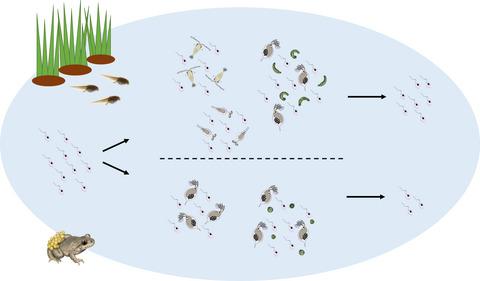当前位置:
X-MOL 学术
›
J. Appl. Ecol.
›
论文详情
Our official English website, www.x-mol.net, welcomes your feedback! (Note: you will need to create a separate account there.)
Alternative food sources interfere with removal of a fungal amphibian pathogen by zooplankton
Journal of Applied Ecology ( IF 5.7 ) Pub Date : 2021-09-04 , DOI: 10.1111/1365-2664.14018 Arne Deknock 1 , Frank Pasmans 2 , Robby van Leeuwenberg 2 , Sarah Van Praet 2 , Stijn Bruneel 1 , Luc Lens 3 , Siska Croubels 4 , An Martel 2 , Peter Goethals 1
中文翻译:

替代食物来源干扰浮游动物去除真菌两栖动物病原体
更新日期:2021-09-04
Journal of Applied Ecology ( IF 5.7 ) Pub Date : 2021-09-04 , DOI: 10.1111/1365-2664.14018 Arne Deknock 1 , Frank Pasmans 2 , Robby van Leeuwenberg 2 , Sarah Van Praet 2 , Stijn Bruneel 1 , Luc Lens 3 , Siska Croubels 4 , An Martel 2 , Peter Goethals 1
Affiliation

|
- While the amphibian disease chytridiomycosis is causing ongoing population declines and biodiversity losses around the globe, efficient mitigation strategies are lacking. The free-living zoospores of the causative agents of this disease, the chytrid pathogens Batrachochytrium dendrobatidis (Bd) and Batrachochytrium salamandrivorans (Bsal), are a potential food source for filter-feeding micropredators as part of the aquatic food web. While consumption of zoospores can lower environmental pathogen loads, alternative food sources may interfere with pathogen removal rates.
- We compared the ability of three filter-feeding zooplankton species, the cladoceran Daphnia magna, the rotifer Brachionus calyciflorus and the ostracod Heterocypris incongruens, to remove Bd zoospores in water and investigated the effect of alternative food sources, the green algae Pseudokirchneriella subcapitata and Chlorella vulgaris, on zoospore ingestion by D. magna.
- Daphnia magna was the only micropredator candidate that effectively removed Bd zoospores from its environment, with an average removal rate of 1,012 ± 542 GE ind.−1 hr−1 within our test system. High concentrations (1 × 105 cells/ml) of large and easily ingestible P. subcapitata reduced pathogen removal rates, whereas the small and less edible C. vulgaris did not interfere with pathogen removal.
- Synthesis and applications. We showed that Daphnia spp., which are keystone species in all sorts of aquatic habitats worldwide, are promising target agents for biologically mitigating chytridiomycosis infections and how natural food sources may interfere with this strategy. We also suggest potential management actions for biological disease mitigation, aiming to optimize environmental conditions for these target filter feeders, thereby reducing pathogen densities and eventually infection pressure in amphibian hosts. Examples of such management actions include, but are not limited to, removal of planktivorous fish, habitat restoration, nutrient control or agrochemical regulation in the vicinity of amphibian breeding ponds. Further studies, including field trials, are needed to confirm the effects of pathogen consumption on infection dynamics in natural situations and investigate the impact of intervention actions.
中文翻译:

替代食物来源干扰浮游动物去除真菌两栖动物病原体
- 虽然两栖动物壶菌病正在导致全球人口持续下降和生物多样性丧失,但缺乏有效的缓解策略。这种疾病的病原体、壶菌病原体Batrachochytrium dendrobatidis (Bd) 和Batrachochytrium salamandrivorans (Bsal)的自由生活游动孢子是滤食性微捕食者的潜在食物来源,是水生食物网的一部分。虽然食用游动孢子可以降低环境病原体负荷,但替代食物来源可能会干扰病原体去除率。
- 我们比较了三种滤食性浮游动物种类中,枝角类的能力水蚤,轮虫萼花臂尾和介形虫Heterocypris incongruens,去除水中屋宇署游动孢子和调查的替代食物源的影响,绿藻门Pseudokirchneriella subcapitata和小球藻,关于D. magna摄入游动孢子。
- Daphnia magna是唯一有效地从其环境中去除 Bd 游动孢子的微型捕食者候选者,平均去除率为 1,012 ± 542 GE ind。-1 hr -1在我们的测试系统中。高浓度(1 × 10 5 个 细胞/ml)的大而易摄取的P. subcapitata降低了病原体去除率,而小而不易食用的C. vulgaris不会干扰病原体去除。
- 合成与应用。我们展示了水蚤spp. 是世界范围内各种水生栖息地的关键物种,是有希望的生物减轻壶菌病感染的靶点,以及天然食物来源如何干扰这一策略。我们还建议了减轻生物疾病的潜在管理行动,旨在优化这些目标滤食性动物的环境条件,从而降低病原体密度并最终降低两栖动物宿主的感染压力。此类管理措施的示例包括但不限于在两栖动物繁殖池附近清除浮游鱼类、恢复栖息地、营养控制或农用化学品监管。进一步的研究,包括田间试验,


























 京公网安备 11010802027423号
京公网安备 11010802027423号